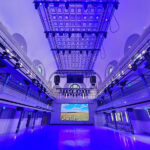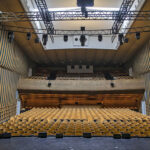When Celine Dion completed A New Day, her five-year stint at the Colosseum at Caesars Palace in Las Vegas, she left behind the 4,000+ capacity venue that was specially built for her, along with its 22,450 square foot stage, its 120 feet wide by 44 feet high proscenium, 1160 conventional luminaires, 140 automated lights, four 10K ANSI lumens projectors, and enough work to keep a good sized tech crew hopping. In her wake came Bette Midler, who was given the showroom with all the sound and lights for The Showgirl Must Go On. All she needed was a little scenery and some props and she had an instant show. Or so it seemed. When long-time Midler production designer Peter Morse came in to do an initial survey of the building in advance of his lighting design, what he found was an eight-year-old lighting system. At the current pace of technological advancement, that made it almost eligible for Medicare. Sure, Dion’s was beautiful show, he thought, but it was 80 percent conventional lights, and the automated lights were, by today’s standards, not up to par.
Bright and Wide
Morse has been Midler’s lighting designer since the late 1980s and early 1990s, and for multiple tours including Experience the Devine, Diva Las Vegas and Kiss My Brass. He won an Emmy for Diva Las Vegas. “I’d like to think I have a pretty good understanding and feel for her. We have a creative team that consists of herself, stage manager Sean Farmer, choreographer Tony Basil, myself and production manager Malcolm Weldon. We met in New York on several occasions along with Eric Kornfeld, her comedy writer, and Bette Sussman, her musical director. As part of the creative group I was involved in whole creative process from the beginning. [Midler] considers every aspect of the show a process in the creation of the show. By the time it got to Vegas, I knew the show, which was a huge help and saved a lot of time.”
And he knew the lighting system simply wouldn’t work for Midler. For starters, Dion’s show and Midler’s are miles apart. “Dion’s show was very cirque-like and shadowy,” Morse said. “Bette’s show is brighter, and she tends to use the entire width of stage,” along with props and gags. There wasn’t enough light, Morse decided.
By that time, Cher had signed on to alternate weeks with Midler and Elton John, who had been sharing the space with Dion when she was there. So Morse set out to create a lighting design that “would work with Bette, but was generic enough to work with all three performers.”
Napkin to Plot
“The initial drawing was on a napkin,” Morse said, “so we could quickly get the rough numbers” for budgeting purposes. “We contacted PRG to get some estimates and then we sat in a room and did rough calculations and then started working.”
Morse knew right off the bat that the estimates would be high. “At 120 feet,” he said, “I don’t care what you put in there, there’s going to be a lot of fixtures.” He stayed within an automated fixture count of 150, including Vari*Lite VL3000s, VL 3500s, some Martin MAC 2000 Wash fixtures, plus some existing house fixtures. The initial cost estimates were in the range of several million dollars.
The napkin drawing became a series of Vectorworks lighting plots. When he brought his design to the table, the reaction was like dropping a bomb on a baby chick. During a meeting with hotel management, Midler, and AEG (who bought the shows), Morse laid out the existing plot from Dion’s show. He then took off an overlay of the conventional lights, leaving only the few automated lights that were left. He explained how many man-hours it would take to focus the conventional lights and why automated lighting would be a better choice. Since they were sharing the room between three artists, maintaining a 24-hour turnaround for each show was important. To further dramatize the need for new equipment, he then showed another drawing with the few remaining in-house lights that were worth keeping.
During the same period, Morse and Michael Levine, the set designer, wrestled over the need for lighting over the stage. Levine wanted to utilize all of the overhead space for set pieces while Morse wanted the sight lines for down lighting and back lighting. “We had several meetings to move scenery around to make room for lighting,” Morse said.
Rough Waters
Management wasn’t happy about the prospect of spending a lot of money to update the system, and they bandied it about for several months. In the end they worked out a deal to split the cost among the performers and the hotel.
In the process, they agreed to strip the room bare and pull out the radical rake in the stage because of the number of injuries suffered by dancers in Dion’s show.
“There was quite a bit of engineering involved,” Morse said. The new design was centered around Midler’s show, with lots of consideration for Cher and Elton. Kevin “Stick” Bye, the LD for Elton John, was by Morse’s account “totally happy,” while Barry “Baz” Halpin had one request; he wanted to trade some of the automated lights for Coemar Infinity Spots and Wash fixtures.
PRG was selected as the lighting supplier with Tim Brennan heading up the project management. While the gear was going in, Morse came and went, periodically checking on their progress. Because of the massive scope of the re-engineering, the sheer number of trades working on site made it a challenge for everyone involved. As soon as there was an opportunity, Eric Wade was brought in to program the console while the automation and the fly system was going in.
But if Wade was expecting smooth sailing at that point, he was in for a surprise. The new lighting system had 32 active DMX512 universes, most of which were more than half full. In Wade’s words, “It’s a lot of gear.”
Drastic Change
Dion’s show was run on two Compulite Sabre consoles through an ETCNet system. The new lighting system is run on a Martin Maxxyz Plus console, so PRG converted to Virtuoso nodes running into the ETC network. But when Wade fired up the console, he found there was a multi-second delay between triggering a cue and the execution of the cue. The old system, it seems, wasn’t designed to handle 32 universes.
So Wade called in a tech, Matt Paupst, and the electrics crew chief, Greg Whittle, to help resolve the problem. The three of them, along with the rest of the crew, ripped apart the entire network and pieced it all back together bit by bit, searching for solutions. For two and a half weeks the troubleshooting went on. In the end, they got it working using an Artistic Licence ArtNet system from the booth running into a Cisco fiber switch that takes the network to multiple Pathport nodes on the stage and in the electrics.
During the troubleshooting, Matthias Hinrichs of Martin Professional came in and totally rebuilt and upgraded the console to a Maxxyz+ and made sure their end of the system was totally functional. By the time everything was working properly there were only 10 programming days left. Wade and Morse began programming 18 hours every day.
“It was a headache,” Wade remembers. “When Greg Whittle, Whit Davis and Matt Paupst eventually figured it out, things changed drastically.”
The Video Elephant in the Room
The show features a considerable amount of video. Carol Dodds is the video director and Olivier created the video content. Because of the lack of time, the decision was made not to wait on the video to finish programming. “We would discuss with [the video designers] the video as far as color goes, but then we would go ahead and light number and make changes after the fact,” Morse said. “There is a 120-foot wide LED wall in the back, and projections. We coordinated them all and it worked beautifully. Hello Again has several levels of projection — a main scrim, 120-foot by 40-foot high full-width projection, midstage traveling chainmail, upstage wall — we use all three elements together with no spotlights. It’s lit entirely with specials.”
For the few times when IMAG is used, Morse and Dodds worked together to get the best results. “It’s a tough room for IMAG because the spot angles are very steep,” Morse said. “There were some old Robert Juliat followspots in house, and they’re really nice spots – perfectly balanced for Celine. But the minute we added 2K and 3K stage fixtures, the existing spots were barely adequate. We now use three of them to light the three Harlettes and we also rent one 3K long throw Lycians specifically for Bette. This light is brought in for each of Bette’s runs.”
100 Percent and On Schedule
During the challenge of opening the show, both Morse and Wade became huge fans of the staff. “This crew is absolutely amazing,” Wade said. “They’re a top notch crew, from spot ops to lighting. They will bend over backwards for you. I will be hard pressed to ever have a crew like this again. They worked 14 to 16 hours per day and never complained about it.”
“We opened at 100 percent,” said Morse, “but it was totally insane. Everyone was fairly stunned, most of all me. I was a pessimist through all this but in the end it all worked, much to Eric Wade’s credit.
“Greg Whittle, the head electrician, and Bob Sandin, the tech director were a huge help,” Morse said. “We have drops and scenery that go 100 feet across, they move left and right, diagonally, and they’re all automated. Considering the amount of time needed for coordinating the lighting programming with all the automated fly cues and the many prop cues, I was pretty amazed that we got it done on schedule.”
Bette Midler, The Showgirl Must Go On
The Colosseum, Caesars Palace, Las Vegas
Crew:
HD: William Whittle, Whit Davis
Tech: Eric “Yoda” Dismuke
Spots: Mike Rogers, Geno Dunn, J-Stan, Gregory Mich’l, Mike Mich’l, Bill Blaydes, Mike Massimo
Deck: Lisa Fernandes, Dan Reagan
Electricians: Geoff Huey, Mike Renken


